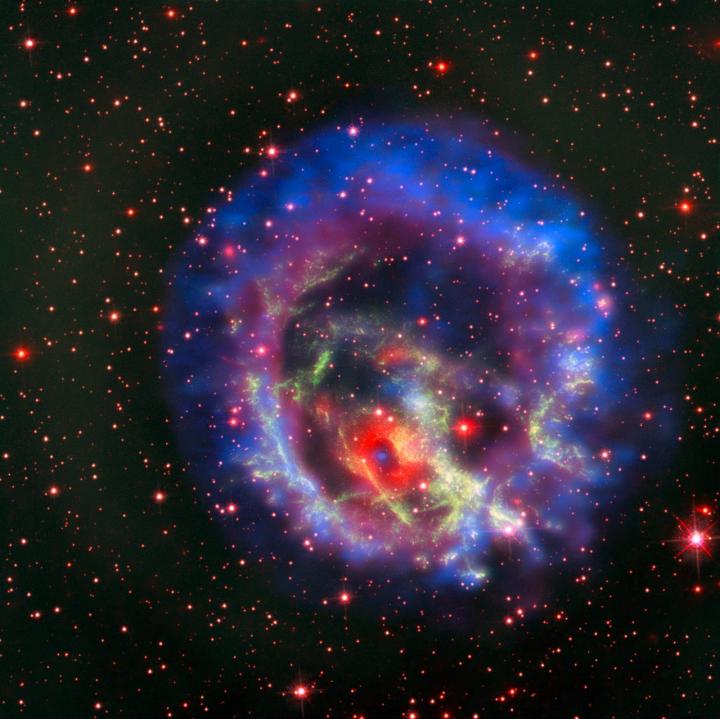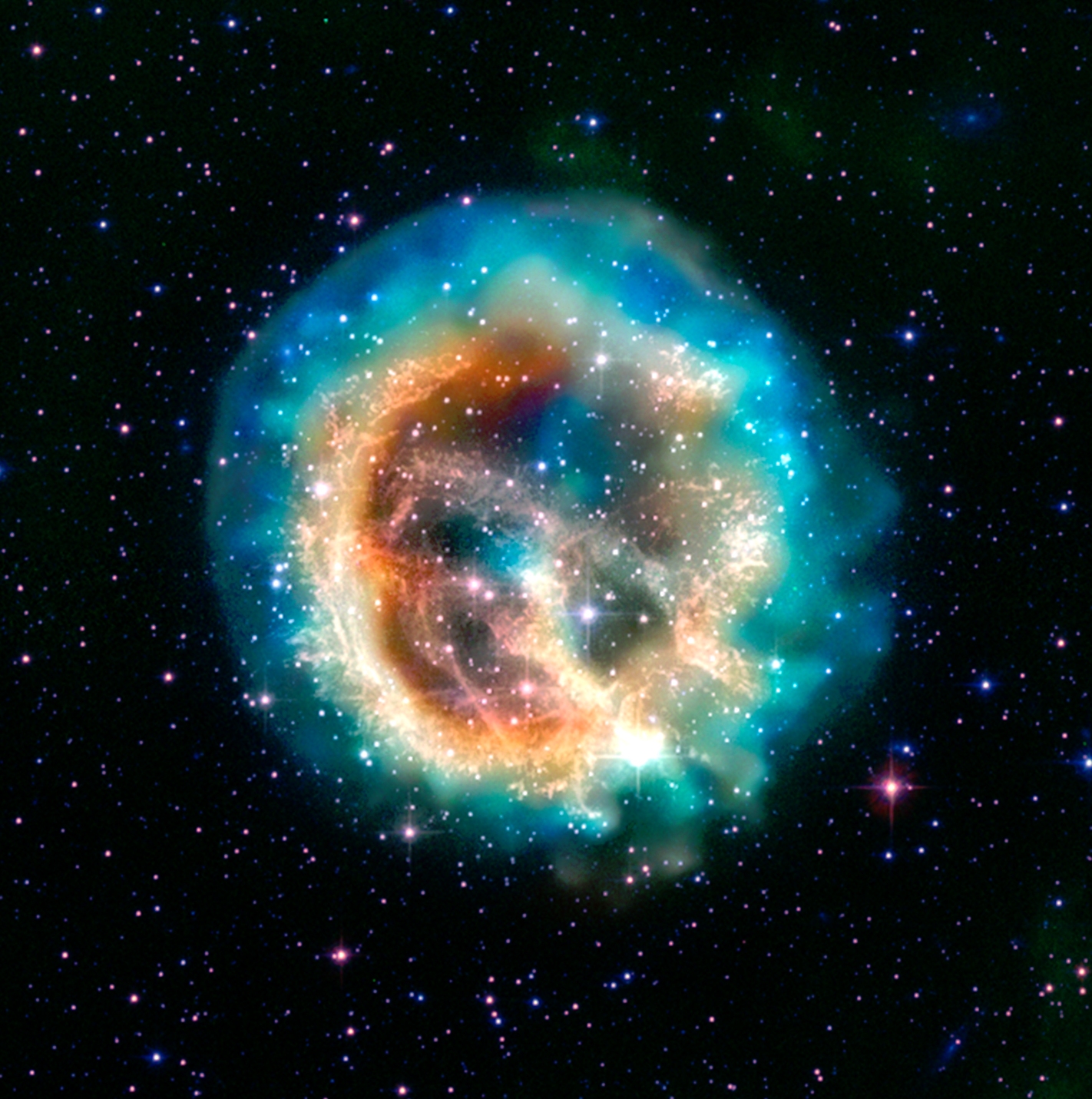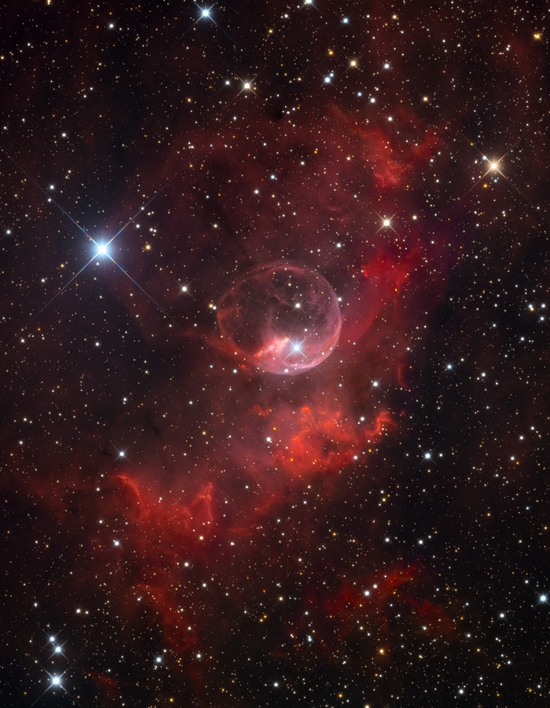It looks like you're using an Ad Blocker.
Please white-list or disable AboveTopSecret.com in your ad-blocking tool.
Thank you.
Some features of ATS will be disabled while you continue to use an ad-blocker.
24
share:
This was an article recently produced and is of interest. The online article picture is zoomable..

www.dailygalaxy.com... #more

New images from ESO's Very Large Telescope and other telescopes reveal a rich landscape of stars and glowing clouds of gas in one of our closest neighboring galaxies, the Small Magellanic Cloud. The pictures have allowed astronomers to identify an elusive stellar corpse left behind by a 2,000-year-old supernova explosion. The MUSE instrument was used to establish where this object is hiding, and Chandra X-ray Observatory data confirmed its identity as an isolated neutron star. Read more at: phys.org...
www.dailygalaxy.com... #more
New data from the MUSE instrument on ESO's Very Large Telescope in Chile has revealed a remarkable ring of gas in a system called 1E 0102.2-7219, expanding slowly within the depths of numerous other fast-moving filaments of gas and dust left behind after a supernova. This discovery allowed a team led by Frédéric Vogt, an ESO Fellow in Chile, to track down the first ever isolated neutron star with low magnetic field located beyond our own Milky Way galaxy. The team noticed that the ring was centred on an X-ray source that had been noted years before and designated p1. The nature of this source had remained a mystery. In particular, it was not clear whether p1 actually lies inside the remnant or behind it. It was only when the ring of gas -- which includes both neon and oxygen -- was observed with MUSE that the science team noticed it perfectly circled p1. The coincidence was too great, and they realised that p1 must lie within the supernova remnant itself. Once p1's location was known, the team used existing X-ray observations of this target from the Chandra X-ray Observatory to determine that it must be an isolated neutron star, with a low magnetic field.
Someday you will find me
Caught beneath the landslide
In a champagne supernova in the sky
Caught beneath the landslide
In a champagne supernova in the sky
a reply to: skywatcher44
S and F for a great find.
The low magnetic field detail is interesting. Correct me if wrong, but doesn't this indicate a high rotation rate of the neutron star? I recall reading that low rotation rates for neutron stars yield powerful magnetic fields, ie: magnetars.
S and F for a great find.
The low magnetic field detail is interesting. Correct me if wrong, but doesn't this indicate a high rotation rate of the neutron star? I recall reading that low rotation rates for neutron stars yield powerful magnetic fields, ie: magnetars.
edit on 462018 by CreationBro because: (no reason given)
a reply to: CreationBro
From a ATS Thread.
www.abovetopsecret.com...
There is now speculation that known periodic pulsars that suddenly exhibit magnetar-like explosions are actually the highly magnetic cousins of pulsars disguised as pulsars. Pulsars simply do not have enough magnetic energy to generate explosions of this magnitude, magnetars do. Fotis Gavriil of NASA's Goddard Space Flight Center in Greenbelt, and his colleagues analysed a young neutron star (called PSR J1846-0258 in the constellation Aquila). This pulsar was often considered to be "normal" due to its fast spin (3.1 revolutions per second), but RXTE observed five magnetar-like X-ray bursts from the pulsar in 2006. Each event lasted no longer than 0.14 seconds and generated the energy of 75,000 Suns. Follow up observations by Chandra confirmed that over the course of six years, the pulsar had become more "magnetar-like". The rotation of the pulsar is also slowing down, suggesting a high magnetic field may be braking its rotation. These findings are significant, as it suggests that pulsars and magnetars may be the same creature, just at different periods of a pulsars lifetime, and not two entirely different classes of neutron star
From a ATS Thread.
www.abovetopsecret.com...
Here's another cool image, using X-rays captured by Chandra telescope, and visible light captured by the Hubble:

Full image
Supernova remnants are some of the most intriguing and colourful objects in the universe.

Full image
Supernova remnants are some of the most intriguing and colourful objects in the universe.
edit on 7-4-2018 by wildespace because: (no reason
given)
a reply to: wildespace
Well, technically, they are made colorful in post-processing. But yeah, they are sure pretty.
Well, technically, they are made colorful in post-processing. But yeah, they are sure pretty.
originally posted by: moebius
a reply to: wildespace
Well, technically, they are made colorful in post-processing. But yeah, they are sure pretty.
You're right. In natural colours, most of nebulae and the like look red/pink, due to copious amounts of ionised Hydrogen.


originally posted by: SR1TX
Why can we not somehow harness this power?
located beyond our own Milky Way galaxy.
in one of our closest neighboring galaxies, the Small Magellanic Cloud.
This is not to say we don't have these in our own galaxy. But in that case they are still too far away I think to harness any power. But when we get some real interstellar spaceships in this bitch, you could just grab an extension cord, and just, toss the male end towards the magnetar, being that it's magnetic it will attach automatically. Then unspool the cord back to earth, plug it into a power strip, and have another heavy duty extension cord plugged into each outlet, and so on, until everyone has power for free...
originally posted by: SR1TX
Why can we not somehow harness this power?
We have a sun right in the middle of our own solar system that has all of the energy we could possibly use if we just harnessed all of it -- or even just a modest percentage of it -- rather than the tiny fraction of a percentage that we do harness.
By the way, that's the idea behind a Dyson Sphere or Dyson Swarm -- i.e., trying to capture a larger percentage of a star's energy output rather than the practically infinitesimal amount a planet alone can harness.
edit on 7/4/2018 by Soylent Green Is People because: (no reason given)
originally posted by: skywatcher44
This
if one looks at the 2 red dots sort of in the middle of the sphere....
one can make-out the faint structure or form of a Head of an Alien... the mouth/lips are fairly self evident , the chin is where it should be... is that 2000 year old event actually & really a 'sign' that we on Earth should be aware of
originally posted by: St Udio
originally posted by: skywatcher44
This
if one looks at the 2 red dots sort of in the middle of the sphere....
one can make-out the faint structure or form of a Head of an Alien... the mouth/lips are fairly self evident , the chin is where it should be... is that 2000 year old event actually & really a 'sign' that we on Earth should be aware of
To each his own, I suppose. In my mind, I see a bear:

edit on 7/4/2018 by Soylent Green Is People because: (no reason given)
new topics
-
America's Greatest Ally
General Chit Chat: 20 minutes ago -
President BIDEN's FBI Raided Donald Trump's Florida Home for OBAMA-NORTH KOREA Documents.
Political Conspiracies: 5 hours ago -
Maestro Benedetto
Literature: 6 hours ago -
Is AI Better Than the Hollywood Elite?
Movies: 7 hours ago -
Las Vegas UFO Spotting Teen Traumatized by Demon Creature in Backyard
Aliens and UFOs: 10 hours ago -
2024 Pigeon Forge Rod Run - On the Strip (Video made for you)
Automotive Discussion: 11 hours ago -
Gaza Terrorists Attack US Humanitarian Pier During Construction
Middle East Issues: 11 hours ago
top topics
-
President BIDEN's FBI Raided Donald Trump's Florida Home for OBAMA-NORTH KOREA Documents.
Political Conspiracies: 5 hours ago, 26 flags -
Krystalnacht on today's most elite Universities?
Social Issues and Civil Unrest: 16 hours ago, 9 flags -
Gaza Terrorists Attack US Humanitarian Pier During Construction
Middle East Issues: 11 hours ago, 8 flags -
Supreme Court Oral Arguments 4.25.2024 - Are PRESIDENTS IMMUNE From Later Being Prosecuted.
Above Politics: 16 hours ago, 8 flags -
Weinstein's conviction overturned
Mainstream News: 15 hours ago, 8 flags -
Massachusetts Drag Queen Leads Young Kids in Free Palestine Chant
Social Issues and Civil Unrest: 13 hours ago, 7 flags -
Las Vegas UFO Spotting Teen Traumatized by Demon Creature in Backyard
Aliens and UFOs: 10 hours ago, 6 flags -
Meadows, Giuliani Among 11 Indicted in Arizona in Latest 2020 Election Subversion Case
Mainstream News: 13 hours ago, 5 flags -
2024 Pigeon Forge Rod Run - On the Strip (Video made for you)
Automotive Discussion: 11 hours ago, 4 flags -
Is AI Better Than the Hollywood Elite?
Movies: 7 hours ago, 3 flags
active topics
-
Is AI Better Than the Hollywood Elite?
Movies • 16 • : 5thHead -
Hate makes for strange bedfellows
US Political Madness • 48 • : Terpene -
America's Greatest Ally
General Chit Chat • 0 • : 19Bones79 -
President BIDEN's FBI Raided Donald Trump's Florida Home for OBAMA-NORTH KOREA Documents.
Political Conspiracies • 17 • : BingoMcGoof -
Gaza Terrorists Attack US Humanitarian Pier During Construction
Middle East Issues • 29 • : 19Bones79 -
Supreme Court Oral Arguments 4.25.2024 - Are PRESIDENTS IMMUNE From Later Being Prosecuted.
Above Politics • 90 • : Lumenari -
Las Vegas UFO Spotting Teen Traumatized by Demon Creature in Backyard
Aliens and UFOs • 12 • : KrustyKrab -
SHORT STORY WRITERS CONTEST -- April 2024 -- TIME -- TIME2024
Short Stories • 23 • : DontTreadOnMe -
Truth Social goes public, be careful not to lose your money
Mainstream News • 130 • : Astyanax -
-@TH3WH17ERABB17- -Q- ---TIME TO SHOW THE WORLD--- -Part- --44--
Dissecting Disinformation • 689 • : daskakik
24
